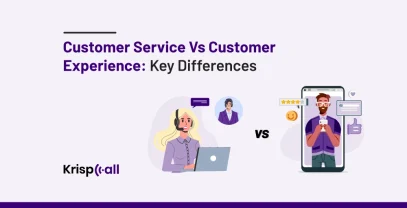Do your clients often complain that you are rude or unclear 🤔? Is your business struggling to find the right way to communicate?
Dealing with customers with the correct ‘Tone of Voice‘ is crucial for good customer service.
A single incorrect word can completely shift a conversation’s tone from positive to negative. Despite the company’s constant effort to make a positive tone of voice throughout the conversation, sometimes hitting the mark is quite difficult, as there are many factors involved in the process.
In this blog post, you’ll learn the importance of tone of voice in customer service and insights on how to utilize it effectively to deliver exceptional customer experiences, including some tips to get the tone of voice just right.
So, let’s get started.
🔑 KEY HIGHLIGHTS
- The tone of voice in customer service represents more than just words; it’s about attitude, expression, and intention, influencing how customers feel during interactions.
- A simple tone of voice has the ability to influence the overall customer experience. It can turn a potentially negative encounter into a positive one.
- A friendly, positive, and polite tone of voice helps build trust and satisfies customers, making them feel valued and heard.
- Some tips to get the tone of voice right include speaking clearly and naturally, maintaining professionalism, reading the situation, and using positive language.
What is the tone of voice in customer service?
The tone of voice in customer service is the general mood or sentiment expressed through written and spoken words by customer service representatives during customer inter

Customers can actually sense your attitude while communicating; they feel you if you are irritated, tired, lazy, or active. Your tone of voice determines whether you have impacted a customer positively or negatively.
An example of a bad tone of voice is if a customer calls the agent regarding a problem or raises a concern and the agent responds with sarcasm or irritation, it can create a negative impact on the customer and can make the customer feel unvalued and frustrated.
An example of a good tone of voice is when agents show genuineness in their voice and use positive language like I’m here to help if you need; in that case, even if the customer is angry, he/she will automatically calm down and focus on problem-solving instead of complaining and fighting.
Why tone of voice is important in customer service?
The tone of voice actually determines whether you have impacted customers negatively or positively. Even though your words are right, your simple tone changes the whole meaning of a conversation.
Therefore, choosing the right tone while speaking can make a huge impact on customers’ experience and the overall relationship between the company and customers.
Some of the other reasons that demonstrate the importance of tone of voice in customer service are;
To gain customer’s trust
An agent’s friendly and genuine tone can positively impact the customer experience. With a friendly and positive tone, the agent not only provides the right information or solves the problem but also makes the customer feel heard and valued.
A positive interaction can leave a lasting impression and even turn a potentially negative experience into a positive one. This helps the customer trust the business more. This means that they will keep using the company’s products or services.
To Satisfy customer
Customer satisfaction is the motto of every company, and this responsibility falls upon a customer service provider. An agent’s talking style, voice tone, and personality affect how a customer perceives any business.
It makes customers feel better when they call customer service and hear a nice voice say hi. In contrast, if a CRS’s voice sounds like he/she doesn’t care enough to solve the customer’s problem, it will have a negative impact on clients, but one can make a good impression by being friendly and enthusiastic, which automatically satisfies them.
To Make a long-term relationship
To make a long-lasting relationship, a company must make its customer feel respected and helpful and show genuine interest in their problem. When companies sincerely commit to their customer need and satisfaction, it will automatically lay a foundation of trust and loyalty.
As a result, customer service agents should deliver service with the right attitude and tone of voice so businesses can have long-lasting relationships.
Recover the relationship
Many customers leave the brand or won’t buy anything from them even when they love the product because of just a single bad experience. Moreover, many customers completely cut off their relationship with a brand after more than two negative interactions.
This will affect the long-term relationship between customer and business. Therefore, if agents speak positively, it can help recover relationships. Due to the positive and warm tone of the agents, customers also think twice before cutting off the relationship.
How to change the tone of customer service encounters?
Change of tone in customer service encounters means changing and adjusting the conversation style based on the platform and customer you are communicating with.
👉 Here are some ways you can use to change the tone of customer service encounters:
1. By matching the tone of your customer
If a business can match a customer’s tone, its engagement rate increases exponentially. Responding with a positive and helpful tone must be the go-to answer for any business. Nevertheless, injecting a bit of wit or humor in reply doesn’t harm anyone; instead, it skyrockets customer interaction. But remember, you have to read the room before providing such a mindful exchange.
2. By changing your tone when communicating on social media
Social media platforms such as X (formerly Twitter), Instagram, and Facebook are common places where you can provide personalized assistance to customers. Moreover, it is one of the fastest and easiest ways of solving clients’ problems.
While communicating on social media, it doesn’t have to be too formal; it can be short, concise, and straightforward. Hence, a business can easily utilize social networks to solve problems by being direct, brief, and simple.
3. By changing tone to convince without being overbearing
A tone of communication is important when reaching customers through email, whether to call them to action, review information, or make an important decision. For this type of conversation, a helpful and reassuring tone is more effective than a direct and informative one.
You can’t be forceful; instead, you should be quick to address potential hesitations and assist them step-by-step, which can increase leads successfully.
4. By changing tone based on the channel of communication
If a service can address customers’ problems and queries wherever they are, it will be easier to create a positive brand image and generate loyal customers.
Through adopting and being versatile, businesses can craft short or long messages in a formal or informal tone on different channels: social media, mail, or calls. As a result, customers in all nooks and corners can connect with the business and elevate their customer service experience.
What are the tips to get the tone of voice just right?
A friendly, positive, and polite tone of voice can help agents and customers build a positive relationship. So, the tone of your voice is as important as the words you say.
👉 Here are some tips to get the tone of your voice just right;
Speak clearly and naturally
Many customer service agents are trained to speak in a clear and natural tone. This helps customers feel more personal and less scripted and builds a genuine 🤗 connection between agent and customer. Similarly, don’t try too hard to sound friendly and polite. This tone might come across as different, which can offend customers.
Maintain professionalism
Speaking naturally in your own natural tone doesn’t mean using slang words or being too casual with your customers. Even though you want to make communication more personalized, you still need to maintain your professionalism.
Read the situation
Every time a customer calls, agents should be able to read the situation with the first line he/she speaks. You should read the customer’s emotional state and be ready to tackle it. If the customer is angry, then you have to stay calm and handle it accordingly.
Be calm and patience
Dealing with an angry 😡 and impatient customer can be really frustrating sometimes. In such cases, try to be calm and not take things personally. Maintaining a calm tone can slowly help you calm the situation, and both the agent and customer can focus on solving the problem.
Use positive language
Agents should strictly maintain positive language while working in a customer service department. Using words like I don’t know, That’s not something we do, can impact a customer negatively. Instead, you can use Let me find out for you. Here’s what we can do for you according to the situation.
Wrapping Up!
The tone of voice is an important aspect for customer service agents. It can significantly impact customers’ overall experience, the relationship between customer and company, and many other factors.
The tone of voice determines whether you have impacted customers negatively or positively. So, choosing a friendly, empathic, professional tone can help you build trust, satisfy your customers, and make a long-term connection with them.
By speaking clearly, maintaining professionalism, reading the situation, showing patience, and using positive language, agents can ensure that every customer interaction leaves a positive impres





